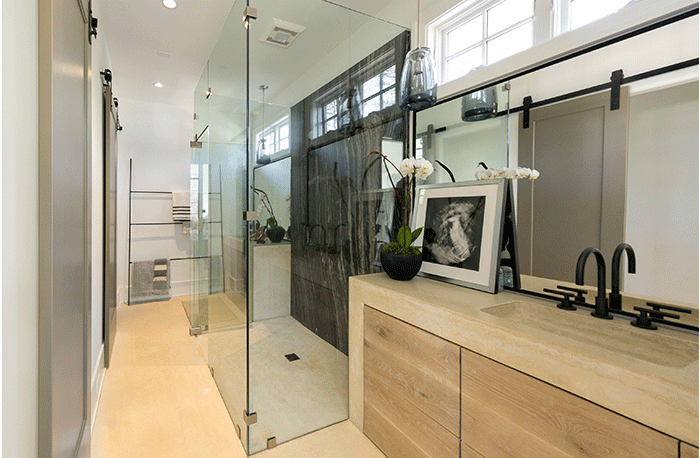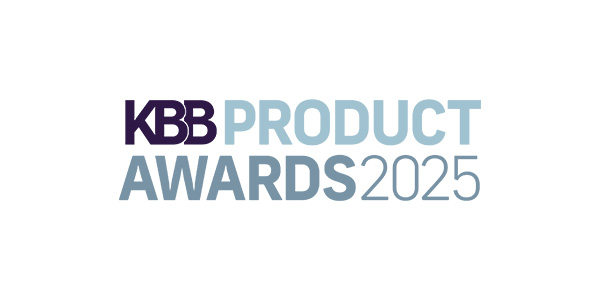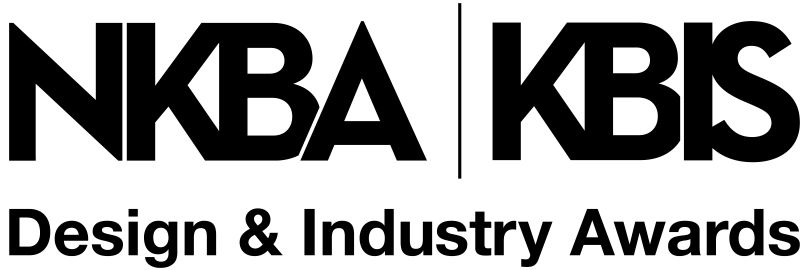Safety in the kitchen and bath has been a concern for many decades. With global health events, including COVID-19, and the growing awareness of the everyday presence of hazardous chemicals within the home, health has become top-of-mind for consumers. Recognizing concerns and understanding and applying a holistic approach to health and safety in living environments is vital to overall well-being.
Above photo: In this Wellness Within Your Walls-certified show home in Atlanta’s Serenbe neighborhood, Dana Lynch Design in collaboration with DES-SYN chose natural stone surfaces, natural light and multiple showerheads to make this bathroom an oasis at home. Photo credit: J. Ashley Master
Kitchens and bathrooms – two of the busiest rooms in a home – pose challenges for occupants for safety and health. It is probably no surprise that most research shows that the bathroom, typically the smallest room in the house, is the location for most injuries. CDC studies show that injuries in or near the bathtub or shower account for about two-thirds of emergency room visits. On the other hand, the kitchen is likely to be where the most serious accidents occur. The kitchen is home to hot appliances that produce toxic gases, heavy cookware, sharp tools and breakable dishes and glassware.
Kitchen Safety
In the kitchen, open flames can be a source of serious injury; therefore, if specifications call for gas appliances, extra precaution is necessary, especially with young children and the elderly. A better alternative is electric appliances; however, they can still pose a safety risk.
In both the kitchen and bathroom, well-planned storage areas are important. Height location should be considered in all zones of the kitchen. Locating heavy items and items used daily in lower cabinets limits the need for stools and ladders. In addition, glassware and dishes can be a safety hazard. Drawers that store dishes and glassware can be a solution instead of traditional upper cabinets.
Bathroom Safety
Within the bathroom, several easy, proactive measures can be taken to avoid common hazards. Non-slip rugs and mats, textured surfaces and grout can help keep materials from contributing to a fall. Removing accessibility barriers to showers and tubs, raising the height of toilets and adding grab bars for the elderly decrease the potential for falls. Making sure adequate lighting is addressed in the design phase can reduce injury. Proper storage and the addition of locks for prescription medication can reduce the risk of accidental consumption.
Mitigating the Impact of Harsh Chemicals
Occupants tend to store cleaners and other toxins in kitchen and bathroom cabinets, making them one of the key areas of concern for human well-being. Common household cleaners are used to mitigate dirt, grime, grease, bacteria, viruses and mold. Disinfectants, such as bleach and ammonia, synthetic air fresheners, anti-bacterial products, aerosol sprays, harsh cleaners and other harsh chemicals are known to be highly toxic and should be stored away from the kitchen or bathroom, preferably in an outdoor, ventilated and locked cabinet. There are nontoxic products on the market that can clean and mitigate viruses, bacteria and other contaminants. When harsh chemicals are required, off-gassing protocols should be implemented.
With the use of fuel-burning appliances, kitchens pose additional concerns. The gases emitted use up fresh air as they burn and give off waste gases, including the highly toxic gas, carbon monoxide. Symptoms of CO2 poisoning include drowsiness and flu-like symptoms. Proper ventilation is key when all stovetop appliances are in use. On the other hand, the use of harsh cleaners and disinfectants and aerosol and other personal care products in the bathroom creates challenges. The bathroom is where most mold issues arise.
Breathing Easier
Air quality in kitchens and bathrooms is critical for health and comfort, made all the more important with energy-efficient homes that require tight building envelopes. Mechanical systems that provide proper levels of ventilation, filtration/purification and (de)humdification are essential, coupled with strategies for proper off-gassing, especially for new appliances. Electric induction/convection stove tops and ovens are safer alternatives.
HVAC systems, range hoods and bathroom fans all play a part in a successful air strategy. During planning stages, all exhaust fans must be vented directly to the exterior. Always run vents when cooking, never block vents and properly maintain appliances by servicing as required. Filters used to purify air must be right-sized, using the appropriate MERV-rated filter that aligns with the system. With a MERV rating of 11 or higher, smaller particulate matter, such as pollen, mold, most bacteria and pet dander, is removed from the air. Increasing to a rating of 13 will include all bacteria and virus carriers.
Air Strategies
Off-gassing strategies, including ceiling fans, open windows and HEPA-filter portable air purifiers, may be necessary when leaks are detected; new products are introduced to the home, such as cabinetry, flooring and furnishings; and finishes are added, such as paints and stains. Without the proper level of humidification, mold thrives and bacteria and viruses are more difficult to control. Integrating smart-home humidification monitors helps control humidity.
Water Quality
Another consumer concern is water conservation and quality; poor water quality can contribute to long-term health risks. Personal, point-of-use or refrigerator purification devices in the kitchen help reduce contaminants in tap water. A whole-home purification system filters all interior water sources. Since skin is the largest human organ, and it absorbs toxins, WHPS provide healthier bathing and laundry alternatives.
Holistic Approach
Implementing holistic thinking with wellness modeling at the beginning of the design process leads to healthier outcomes for the occupant. A holistic approach to health in the home requires a strategy based on the interconnection of many parts. Third-party certifications for homes and building products and health and wellness standards help developers, architects, builders and interior designers understand the holistic approach through proper education, which leads to safer and healthier living environments. This holistic approach considers the occupant needs, home location, climate, mechanical systems and wellness modeling.
Design for well-being and building safer and healthier homes using wellness modeling help make healthier living environments achievable. Do you measure up?
By Jillian Pritchard Cooke, founder of Wellness Within Your Walls, a third-party certification program.








